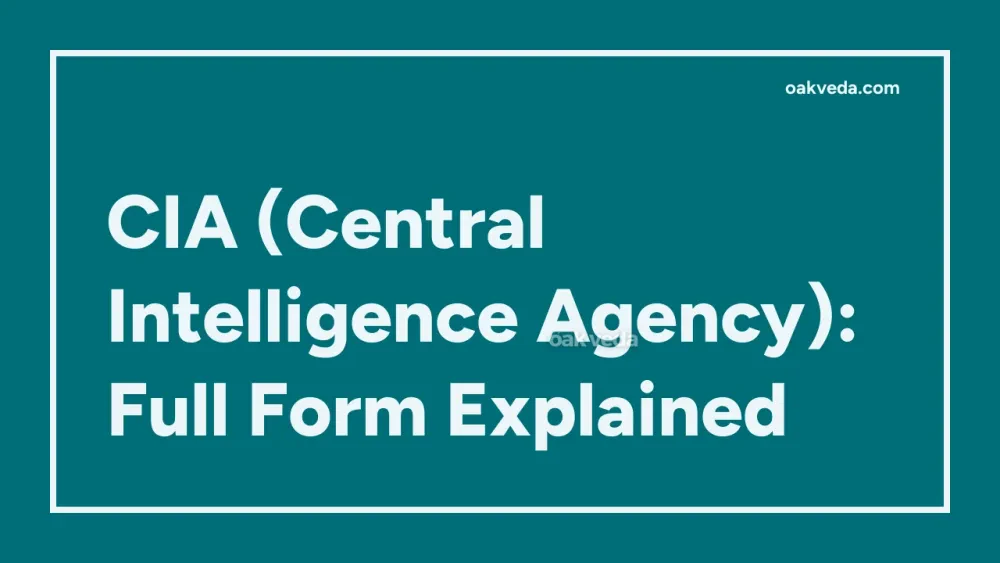
What is the Full Form of CIA?
The full form of CIA is Central Intelligence Agency. As the primary civilian foreign intelligence service of the United States, the CIA plays a crucial role in gathering, processing, and analyzing national security information from around the world.
What is Central Intelligence Agency?
The Central Intelligence Agency is a civilian intelligence agency of the federal government of the United States. It operates under the jurisdiction of the Director of National Intelligence and is primarily focused on providing intelligence for the President and Cabinet of the United States.
Origin and Development of Central Intelligence Agency
The CIA was established on September 18, 1947, when President Harry S. Truman signed the National Security Act into law. This act was a major restructuring of the United States' national security apparatus, created in response to the changing global landscape following World War II.
Key milestones in the CIA's development include:
- 1947: Establishment of the CIA
- 1961: Bay of Pigs Invasion
- 1975-76: Church Committee investigations
- 2001: Enhanced role in counterterrorism post-9/11
- 2004: Intelligence Reform and Terrorism Prevention Act
How does Central Intelligence Agency work?
The CIA operates through a complex network of officers, analysts, and support staff. Its primary functions include:
- Intelligence Collection: Gathering information through various means, including human intelligence (HUMINT) and technical intelligence (TECHINT).
- Intelligence Analysis: Processing and interpreting collected data to produce actionable intelligence.
- Covert Operations: Conducting secret operations as directed by the President.
- Counterintelligence: Protecting against espionage and other intelligence activities conducted by foreign powers.
Types of CIA Operations
The CIA engages in various types of operations, including:
- HUMINT Operations: Gathering intelligence through human sources
- SIGINT Operations: Collecting and analyzing signals intelligence
- OSINT Operations: Analyzing open-source intelligence
- Paramilitary Operations: Conducting covert military-style operations
Functions of Central Intelligence Agency
The CIA's primary functions include:
- Collecting foreign intelligence relevant to national security
- Providing intelligence analysis to policymakers
- Conducting covert operations as directed by the President
- Safeguarding intelligence sources and methods
- Liaising with other intelligence agencies, both domestic and foreign
Applications of Central Intelligence Agency
The CIA's work has wide-ranging applications, including:
- Counterterrorism: Identifying and disrupting terrorist networks
- Nonproliferation: Monitoring and preventing the spread of weapons of mass destruction
- Cybersecurity: Protecting against cyber threats to national security
- Economic Intelligence: Analyzing global economic trends and their impact on US interests
Features of Central Intelligence Agency
Key features of the CIA include:
- Global Presence: Operating in numerous countries worldwide
- Advanced Technology: Utilizing cutting-edge tools for intelligence gathering and analysis
- Diverse Workforce: Employing experts from various fields and backgrounds
- Compartmentalization: Strict need-to-know basis for information sharing
Benefits of Central Intelligence Agency
The CIA provides several benefits to the United States:
- Enhancing national security through timely intelligence
- Supporting informed decision-making by policymakers
- Providing early warning of potential threats
- Facilitating international cooperation on shared security challenges
Limitations or Challenges of Central Intelligence Agency
Despite its capabilities, the CIA faces several challenges:
- Oversight and Accountability: Balancing secrecy with democratic oversight
- Ethical Concerns: Navigating complex moral dilemmas in intelligence operations
- Technological Advancements: Keeping pace with rapidly evolving technologies
- Information Overload: Managing and analyzing vast amounts of data
Future Developments in Central Intelligence Agency Technology
The CIA continues to evolve, with future developments likely to include:
- Enhanced artificial intelligence and machine learning capabilities
- Improved quantum computing for data analysis
- Advanced cyber operations and defense mechanisms
- Increased use of open-source intelligence gathering
FAQs on CIA Full Form
-
What is the CIA's primary mission? The CIA's primary mission is to collect, analyze, evaluate, and disseminate foreign intelligence to assist the President and senior US government policymakers in making decisions relating to national security.
-
Who oversees the CIA? The CIA is overseen by the Director of National Intelligence and reports to the President, National Security Council, and Congress.
-
Is the CIA a law enforcement agency? No, the CIA is not a law enforcement agency. It is prohibited from collecting information about domestic activities of US citizens.
-
How does one join the CIA? The CIA recruits through its website, offering various career paths for individuals with diverse skills and backgrounds.
-
What is the difference between the CIA and FBI? While the CIA focuses on foreign intelligence, the FBI is primarily a domestic intelligence and security service responsible for internal intelligence and federal law enforcement.
In conclusion, the Central Intelligence Agency, or CIA, plays a vital role in safeguarding US national security through its intelligence gathering and analysis capabilities. As global challenges evolve, the CIA continues to adapt, leveraging advanced technologies and diverse expertise to fulfill its mission in an increasingly complex world.
You may be interested in:

